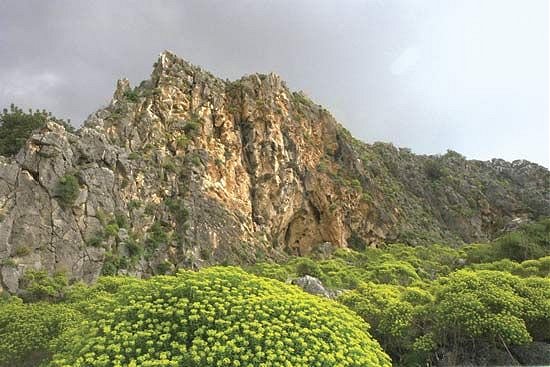
CARMEL.
MOUNT CARMEL is not, as one might suppose, an isolated mountain, but a continuous range of hills, probably about eighteen miles long, with an average height of 1,500 feet. These mountains run inland, from the Mediterranean in a southeasterly direction. At the western end, or more properly, the northwestern, the range terminates in a bold promontory, which forms the southern headland of the Bay of Acre.
The view given in our picture is from the north; and the travelers, with their laden mules and horses, are on the shore of the northern headland of the bay of which Carmel forms the southern:
The mountains of Carmel are of compact limestone, and on the northeastern side, steep and precipitous, deeply furrowed with rocky ravines, which are filled with dense jungles, and inhabited by jackals, hyenas, and wolves. In the sides toward the sea are numerous caves and grottoes, formed partly by nature and partly by the work of men. These were anciently used as hiding-places by refugees;- and at one time Carmel is said to have swarmed with monks and hermits, who made these caves their home. The entrances are so narrow that only one person can creep in at a time, and the caverns so crooked that he is immediately lost sight of unless closely followed.
Thus we see the fitness of the reference of the prophet Amos, when, speaking the words of Jehovah, he says, "Though they hide themselves in the top of Carmel, I will search and take them out thence." This mountain was frequently visited by the prophet Elijah, and to this day is shown a cavern called the "cave of Elijah." It has been thought—and it is not unlikely—that it was in Carmel that the prophet called down fire upon the two fifties sent by Ahaziah to take him.
The southwestern side of the ridge is not so steep and rugged as the northeastern, but sinks down gradually into wooded hills, with well-watered valleys, presenting to the eye a district of great fertility; and declining gently into the beautiful plain of Sharon, lying along the Mediterranean. Carmel, in the Hebrew language, signifies park, or garden-like tract, a name, which the mountain may well claim from its beauty and fruitfulness. It is sprinkled with fine oaks and other forest trees in its upper parts, and olive and fruit trees farther down. Says a writer who has visited the place: "Long, deep ravines of singular wildness wind down the mountain sides, filled with tangled copse, fragrant hawthorn, myrtle, and jess amine, and alive with the murmur of tiny brooks and the songs of birds. At intervals along the slopes are open glades, carpeted with green grass, and spangled with myriads of wild-flowers of every hue." Another says that he is sure a botanist might spend a year in this locality, and every day add new specimens to his collection.
The northwestern extremity of the range is, however, more bleak and barren; and here, over-looking the blue waters of the Mediterranean, stands the convent of the Carmelites, said to be one of the finest in the world. It can be plainly seen in the picture, far up on the hillside above the town. The building is a modern one, erected on the site of a more ancient structure. At this end of the range, on the shore at the foot of the mountain, is situated the town of Haifa, a seaport on the Mediterranean. Late travelers speak of finding here a colony of about one thousand foreigners, chiefly Germans, who are quite transforming the squalid little town. They believe in the speedy coming of Christ to establish his kingdom, making Palestine his gathering place; and they are here to prepare the way by spreading Christian civilization, through means of modern agriculture, manufactories and the like. They are both zealous and industrious, and their neat gardens, streets, and houses make the place look quite inviting.
The scene of Elijah's sacrifice in the days of Ahab, seems to have been near the south-eastern extremity of Carmel. Some have thought that they could identify the very spot; namely, a terrace of natural rock, which bears the Arabic name El Mukrak, alt, meaning "the sacrifice," or "place of burning." From this place there is a narrow pass leading down to the River Kishon, which flows at the base of the mountain; and it is supposed that down this track the idolatrous priests were hurried to meet their death beside the stream; for, part way down, is a point known as Tell Kussi, which means "hill of the priests." From the terrace where it is supposed the altars were built, a few minutes' climbing would have brought the servant of Elijah to the top of a projecting peak, whence he could command a full view of the sea, which is not far from ten miles distant.... The fountain, from which the water was probably drawn to deluge the sacrifice of Elijah, still sends forth its crystal stream; and near it are massive stones, which may have been used in the construction of the altars.
Travelers wax eloquent in their descriptions of this remarkable mountain, and in the thought that their feet have rested, and their eyes gazed, on the very spots where such wonderful things have transpired. Carmel has always been venerated, and to this day it is held sacred by Jews, Christians, and Moslems alike.
E. B. G.